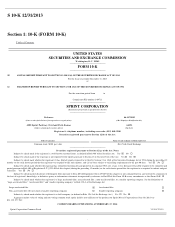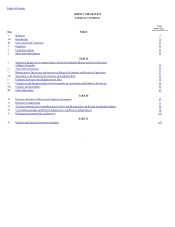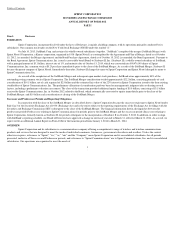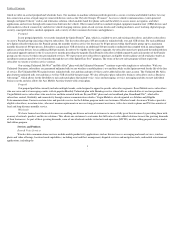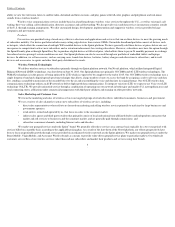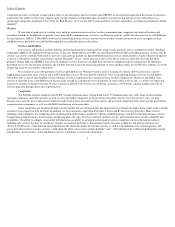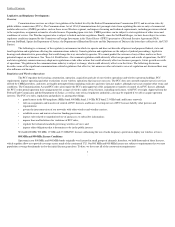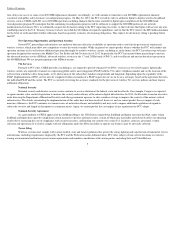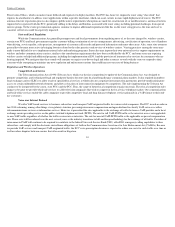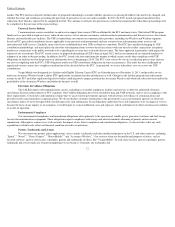Sprint - Nextel 2013 Annual Report Download - page 7
Download and view the complete annual report
Please find page 7 of the 2013 Sprint - Nextel annual report below. You can navigate through the pages in the report by either clicking on the pages listed below, or by using the keyword search tool below to find specific information within the annual report.
Table of Contents
Although we market our services using traditional print and television advertising, we also provide exposure to our brand names and wireless
services through various sponsorships, including the National Association for Stock Car Auto Racing (NASCAR®
)
and the National Basketball Association
(NBA). The goal of these marketing initiatives is to increase brand awareness and sales.
Our customer management organization works to improve our subscribers' experience, with the goal of retaining subscribers of our wireless services.
Customer service call centers receive and resolve inquiries from subscribers and proactively address subscriber needs.
Competition
We believe that the market for wireless services has been and will continue to be characterized by competition on the basis of price, the types of
services and devices offered, and quality of service. We compete with a number of wireless carriers, including three other national wireless companies: AT&T,
Verizon Wireless (Verizon) and T
-
Mobile (together with us
-
"Big 4 carriers"). Our primary competitors offer voice, high
-
speed data, entertainment and location
-
based services and push
-
to
-
talk
-
type features that are designed to compete with our products and services. AT&T and Verizon also offer competitive wireless
services packaged with local and long distance voice, high
-
speed Internet services and cable and have significant competitive advantages due to their large
asset bases and greater scale. Our prepaid services compete with a number of carriers and resellers including TracFone Wireless, which offers competitively
-
priced calling plans that include unlimited local calling. Additionally, AT&T, T
-
Mobile and Verizon also offer competitive prepaid services and wholesale
services to resellers. Competition will increase as a result of mergers and acquisitions, as new firms enter the market, and as a result of the introduction of other
technologies such as LTE, the availability of previously unavailable spectrum bands, such as the AWS
-
4 spectrum band, and the potential introduction of new
services using unlicensed spectrum. Wholesale services and products also contribute to increased competition. In some instances, resellers that use our
network and offer similar services compete against our offerings.
Most markets in which we operate have high rates of penetration for wireless services, thereby limiting the growth of subscribers of wireless
services. As the wireless market has matured, it has become increasingly important to retain existing subscribers in addition to attracting new subscribers,
particularly in less saturated growth markets such as those with non
-
traditional data demands. Wireless carriers are addressing the growth in non
-
traditional
data needs by working with OEMs to integrate connected devices such as after
-
market in
-
vehicle connectivity and electric vehicle charging stations, point
-
of
-
sale systems, kiosks and vending machines, asset tracking, digital signage, security, smartgrid utilities, medical equipment and a variety of other consumer
electronics and appliances, which utilize wireless networks to increase consumer and business mobility. In addition, we and our competitors continue to offer
more service plans that combine voice and data offerings, plans that allow users to add additional mobile devices to their plans at attractive rates, plans with a
higher number of bundled minutes included in the fixed monthly charge for the plan, plans that offer the ability to share minutes among a group of related
subscribers, or combinations of these features. Consumers respond to these plans by migrating to those they deem most attractive. In addition, wireless carriers
also try to appeal to subscribers by offering certain devices at prices lower than their acquisition cost. We may offer higher cost devices at greater discounts
than our competitors, with the expectation that the loss incurred on the cost of the device will be offset by future service revenue. As a result, we and our
competitors recognize point
-
of
-
sale losses that are not expected to be recovered until future periods when services are provided.
During 2013, wireless carriers introduced new plans that allow subscribers to forgo traditional device subsidies in exchange for lower monthly service
fees, early upgrade options, or both. In addition, in the later part of 2013, each of the Big 4 carriers launched early upgrade programs that include the device
installment payment model. The objective of these plans is to attract subscribers away from device subsidies in exchange for greater upgrade flexibility and data
usage options. Under installment billing plans, many carriers, like Sprint, will recognize most of the future expected installment payments for the device on an
upfront basis. This accounting treatment allows the carriers to better match equipment revenue with the cost of the device and minimizes the amount of subsidy
recognized. On January 10, 2014, Sprint replaced its recently launched Sprint One Up
SM
Plan, a device upgrade and installment payment plan, with the Framily
plan. During 2013, the impact to our consolidated financial statements from our installment billing plan was not material.
In addition, we have recently seen aggressive marketing efforts initiated by our competitors, including offering lucrative payments as an additional
incentive for subscribers to switch carriers. If, in response to these
5

